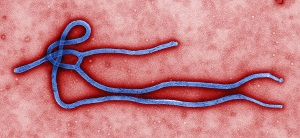 |
| Ebola virus under an electron microscope--Courtesy of CDC |
Since the H1N1 pandemic scare revealed the shortcomings of U.S. production capacity when faced with an emergency, the Department of Health and Human Services (HHS) has invested in facilities to bolster defenses. With the death toll from Ebola now nearing 1,000, the plants are ready to switch to producing a drug or vaccine to protect people against the virus.
The U.S. has three Centers for Innovation in Advanced Development and Manufacturing designed to produce drugs and vaccines in response to public health emergencies. Each is ready to dedicate capacity to Ebola if asked, Reuters reports, and the facilities' focus on speed should mean drugs or vaccines begin rolling off the production line sooner than at traditional plants. The diversity of Ebola candidates and their early-stage nature may test the effectiveness of the facilities.
"The whole idea is to take a process that may exist only on sticky notes at a small biotech company and scale it up as fast as possible," Brett Giroir, chief executive of Texas A&M Health Science Center, told Reuters. Texas A&M runs one of the facilities in collaboration with GlaxoSmithKline ($GSK). As the only one of the three facilities to have capacity to manufacture drugs in plants, the Texas A&M site could be called upon if Mapp Biopharmaceutical's tobacco-produced antibodies are needed.
Emergent Biosolutions ($EBS) and Novartis ($NVS) run the other two facilities, which could play a role if production of one of the other Ebola candidates--such as Tekmira Pharmaceuticals' RNAi drug--is requested. Such a request would come from the highest levels of the Obama administration, at which point the federal machine would kick into action. HHS also has vial-filling arrangements with Baxter ($BAX), Cook Pharmica and JHP Pharmaceuticals.
- read Reuters' feature